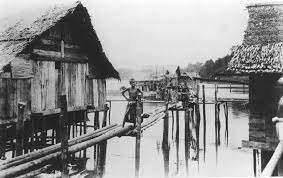REMARKABLE ORIGINS AND FASCINATING TALES OF KG AYER
Facts you may not know about the ancient floating city
Disclaimer: The blog is presented in a narrative manner to stimulate readers' imagination. It draws inspiration from real history, folklore, and oral heritage. While the information provided is based on these sources, it is important to note that historical facts and written records on the early period may not always be highly accurate. Nevertheless, we will strive to rely on widely accepted sources as our guiding reference.
Illustration called ‘Bruni (Borneo Proper)‘ by artist F. M. Del, circa 1844. It depicts the arrival of Resident James Brooke to Brunei Town aboard the Semarang ship. This is the visit that played a significant role in eradicating piracy and the concession of Labuan Island to British rule. Source: Frank S. Marryat’. (1848) Borneo and the Indian Archipelago. London: Longman & Co.
As you approach the city’s waterfront, it is hard to miss the island of houses on wooden stilts across the Brunei River. This is the largest water village in the world, Kampong Ayer (Kg. Ayer). The murky river carries within its embrace a tapestry of centuries-old memories and heritage. Generations of fishermen have cast their nets into the swirling currents, their daily toil interwoven with the ebb and flow of traditions passed down from their forefathers. The river, their lifeblood, has sustained their communities and its significance transcends time.
A Story Unbeknownst To Many
A millennium ago, Kampong Ayer thrived as a bustling river metropolis, its very existence woven into the fabric of the waterways. While it is often referred to as the 'Venice of the East,' a moniker attributed to Antonio Pigafetta, it was equally hailed as the 'floating city'. Though many now doubt its similarity, in those bygone days, this enchanting settlement was a captivating testament to human ingenuity and adaptability.
Amidst the meandering currents, the sight that greeted onlookers was nothing short of awe-inspiring. Majestic tiered wooden palaces rose gracefully above the river, their intricate designs and ornate carvings a testament to the craftsmanship of the era. These palaces, housing the noble elite, were a sight to behold, offering breathtaking views of the river and traditional Malay architecture.
Yet, it was not just the palaces that captured the imagination. The network of conjoined houses on stilts formed a labyrinthine maze of interconnected walkways, creating a vibrant and cohesive community. Families nestled within these stilt houses, their abodes overlooking the ever-flowing river. The rhythmic sound of wooden planks underfoot and the gentle sway of the structures with each passing boat added to the charm of daily life.
In the historic Kampong Ayer of Brunei, traditional stilt houses gracefully stand, constructed with an assortment of boards and embellished with palm leaf roofs. These charming houses are interconnected by wooden timber and logs, forming a distinctive architectural allure. Source: Information Department.
Kampong Ayer's vibrant atmosphere extended beyond its architectural wonders. Floating markets came alive with the exchange of goods and lively banter. Colorful boats, laden with an abundance of fresh produce, spices, and handicrafts, bobbed gently on the water's surface. The air was filled with the aromas of exotic spices and the melodic calls of the vendors, enticing visitors and locals alike to explore the myriad treasures on offer.
The floating market led by a group of female peddlers called Padian, who traversed from one village to another, selling produce, handicrafts, and trading with fishermen. Unfortunately, limited photographs of this legendary Padian community exist, with the last reported sighting dating back to the 1960s. However, their story stands as a testament to the economic independence achieved by the women of Kg. Ayer. Source: Brunei Resources.
But who were the river people and how did it become home to thousands of residents?
No novels can rival the captivating origin stories of the water village and the enigmatic legends that shroud its surrounding islands. Curiosity often arises as to why the early inhabitants chose to erect a city above water and how it managed to withstand the trials of time. Kg Ayer holds a significant position as the ancestral home of the indigenous Melayu Brunei (ethnic Brunei-Malay) community and its esteemed nobility, solidifying its status as the de facto capital over the years.
‘Natives of Bruni‘ Illustration by Frank S. Marryat. The scene captivated the author so much that he sketched it while aboard a moving steamship, just as they neared Kg. Ayer's palace. The focus of his sketch was the Royal guards and warriors, who had been entrusted with the duty of welcoming James Brooke's delegation and facilitating their audience with the King of Borneo. Source: Borneo and the Indian Archipelago (1848), London; Longman & Co.
In the era of the first line of kings, the entire city was an unexplored, mangrove paradise. The noble families realized that in order to establish their dominance over this newly discovered land, they had to gain control over its vital gateway - the Brunei River. Their conquest propelled them through the narrow waterways into the heartland, where diverse indigenous cultures converged, ultimately giving rise to the ancient Brunei population.
Shortly thereafter, traders, sailors, travelers, and even seafaring nomads flocked to the floating city, bringing about a remarkable transformation as it evolved into a flourishing settlement. Quaint clusters of villages emerged along the river and its surrounding isles, adding to the charm and vibrancy of the locale.
Aerial view of Kampong Ayer (formerly Brunei Town) and clusters of small settlements along the Brunei river, circa 1950s. Source: Brunei Resources
From the 13th to the 16th century, Brunei experienced a period of flourishing growth, evolving into a formidable naval empire. Its dominion expanded across vast territories that reached as far as present-day Philippines and the surrounding regions of Borneo Island. Within Brunei, Kg. Ayer held a pivotal role as the center of significant events, bearing witness to legendary incidents that unfolded on four intriguing islands […]






